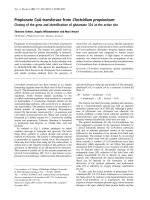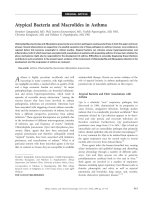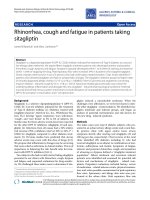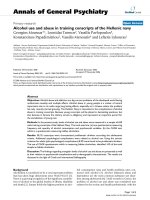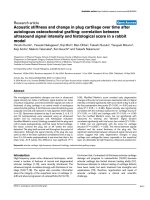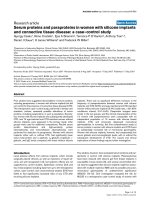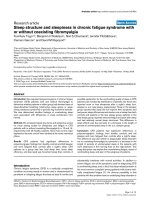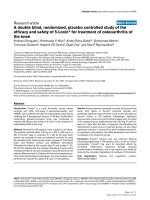Báo cáo y học: "Alcohol use and abuse in training conscripts of the Hellenic navy" pps
Bạn đang xem bản rút gọn của tài liệu. Xem và tải ngay bản đầy đủ của tài liệu tại đây (252.44 KB, 6 trang )
BioMed Central
Page 1 of 6
(page number not for citation purposes)
Annals of General Psychiatry
Open Access
Primary research
Alcohol use and abuse in training conscripts of the Hellenic navy
Georgios Moussas*
1
, Leonidas Tzemos
2
, Vassilis Pavlopoulos
3
,
Konstantinos Papadimitriou
2
, Vassilis Menoutis
4
and Lefteris Lykouras
1
Address:
1
Secont Psychiatric Department Medical School University of Athens "Attikon" General Hospital, Athens, Greece,
2
Office of Preventive
Mental Health, Hellenic Navy, Skaramangas, Greece,
3
Department of Psychology, University of Athens, Athens, Greece and
4
Athens Naval Hospital
, Hellenic Navy , Athens, Greece
Email: Georgios Moussas* - ; Leonidas Tzemos - ; Vassilis Pavlopoulos - ;
Konstantinos Papadimitriou - ; Vassilis Menoutis - ; Lefteris Lykouras -
* Corresponding author
Abstract
Objectives: Alcohol abuse and addiction are big current problems of the developed world having
multivariate causality and multiple effects. Alcohol abuse in young people is a matter of central
importance due to its wide range long lasting effects, especially so in Greece where the problem
has only recently started growing. The Hellenic Navy is interested in the complications of alcohol
abuse in training conscripts. Because young conscripts will be placed in demanding positions, but
also because in Greece the military service is obligatory and represents an important period for
the socialization of young men.
Methods: In the present study, levels of alcohol use and abuse were measured in a sample of 650
male training conscripts of the Hellenic Navy. The tools used are: (a) two questionnaires measuring
frequency and quantity of alcohol consumption and psychosocial variables, (b) the CAGE test,
which is a questionnaire measuring hidden alcoholism.
Results: 38,1% conscripts were characterized problematic drinkers according the adolescents
criteria. Additional psychological complications were related to alcohol use. Using the stricter
criterion for adults (plus psychological complications) 8.9% were found to be problematic drinkers.
The use of CAGE questionnaire which is measuring hidden alcoholism, identified 16% of the total
sample as hidden alcoholics.
Discussion: The findings regarding unregular levels of alcohol use and abuse are presented as well
as their relation to psychosocial complications and to demographic characteristics. The results are
discussed in the light of Creek and international bibliography.
Background
Alcoholism is considered to be a very important problem
that has taken huge dimensions since World War II [1].
There is a growing recognition of the significant contribu-
tion of alcohol to the global burden of illness, disability
and death [2]. Europe holds the highest position in alco-
hol consumption rates and health problems rates con-
nected with alcohol [3]. Alcohol (ethanol) abuse and
dependence are the most common substance use disor-
ders among adolescents [4]. Until recently in Greece, the
problem of alcohol use and abuse was considered non
existent by the society and health professionals, with the
Published: 29 November 2006
Annals of General Psychiatry 2006, 5:21 doi:10.1186/1744-859X-5-21
Received: 02 January 2006
Accepted: 29 November 2006
This article is available from: />© 2006 Moussas et al; licensee BioMed Central Ltd.
This is an Open Access article distributed under the terms of the Creative Commons Attribution License ( />),
which permits unrestricted use, distribution, and reproduction in any medium, provided the original work is properly cited.
Annals of General Psychiatry 2006, 5:21 />Page 2 of 6
(page number not for citation purposes)
exception of specialists dealing with substance use prob-
lems.
Recent evidence, however, has changed the picture. Such
evidence comes from studies that have shown an increase
in per capita consumption of pure ethanol as well as a
change in the traditional manner of alcohol consumption
the last two decades compared with previous consump-
tion [5-8]. Further evidence comes from identifying alco-
hol use and abuse, in general hospitals inpatients [9-11]
as well as from studies in the general population [12,13].
Alcohol consumption and harm indicators like hospital
discharges, injury and poisoning per 100.000 popula-
tions, classify Greece 17
th
in a total of 52 countries [14].
Studies of the Athens University Mental Health Research
Institute showed a rise in the rates of students presenting
a very frequent consumption of alcoholic drinks. The
mean age of onset of alcohol consumption in Greece
appears to be similar with that of 35 other countries [6,7].
Alcohol abuse among adolescents and its complications
are considered to be major public health issues of the
developed world [15-18], since alcohol abuse in adoles-
cents and young adults is known to be related to high risk
for life loss [19-22]. Alcohol abuse is especially known to
play a major role in traffic accidents (fatalities and injury
accidents). Greece has one of the highest rates of fatal traf-
fic accidents among the countries of the European Union
[23]. According to a recent study 45% of lethal traffic acci-
dents in Greece are related to alcohol concentration of 0.5
g/l [24].
Training conscripts of the Hellenic Navy can be consid-
ered to be a good sample of healthy young males as their
ages normally falls between 18 and 24 years. However,
about 10–20% of the conscripts are usually older than 25
years [25,26]. Thus, the diversity in the age range of con-
script personnel in the Armed Forces, made the use of
both questionnaires compulsory on older adolescents and
young adults into separation the two age subgroups was
not feasible for technical reasons (as for the age mixed
military units), on the other hand any research studying
alcohol consumption among such a sample should be
very carefully designed. The tools used to measure alcohol
consumption of adolescents/young adults are different
from those used in older age groups [13]. It is very impor-
tant for the Hellenic Navy to have a profile of alcohol use
and abuse of the training conscripts, firstly because the
Navy is responsible for the conscripts' health while they
are in service, and secondly because the conscripts are
placed in responsible and demanding positions. It is also
known that the period of obligatory military service is a
high stress one and alcohol abuse and stress are related to
violence, suicidality and self harm acts [19,27].
The aim of the present study is a twofold one, i.e. to meas-
ure problematic drinking among training conscripts of the
Hellenic Navy both by adult and by adolescent standards,
and to measure levels of hidden alcoholism in the same
sample. Problematic drinking is a bi-axial measure involv-
ing frequency and quantity of alcohol use, along with psy-
chosocial complications related to alcohol use.
Problematic alcohol use is considered to be a predictor for
future alcohol abuse and/or addiction problems. The con-
sequence of "problematic use" is gradual habituation on
pathological use that is not appears, because of social cul-
ture and social culture and youth habits [13]. Hidden
alcoholism is because of an indirect measure of existing
alcohol abuse and/or addiction, which is employed in
order to avoid the large number of false negative response
produced by traditional tools measuring alcoholism [28].
Method
Sample
Six hundred and sixty (660) training conscripts of the Hel-
lenic Navy participated in the study. The subjects' age
ranges from 18 to 37 years (Mn = 22.0, St.dev = 2.8).
Almost 20% (n = 118) were older than 25 years of age.
They came from different parts of Greece (63.8% from
Athens, Thessaloniki or other big cities; 25.6% from little
towns or villages; and 10.6% from islands). Their educa-
tion varies from basic – 6 years – (8.0%), and secondary –
12 years – (17.3%), to technical/professional – 9 years –
(39.1%), and University – 16 or more years – (35.5%).
Only 18 (2.7%) conscripts were married, while the par-
ents of 50 (7.6%) were separated or divorced. It must be
noted that all subjects were qualified as being capable of
serving the Armed Forces (subjects suffering from serious
physical or psychiatric diseases had already received a
deferment or a discharged).
Measures and procedure
The following tools were used, (a) a questionnaire meas-
uring frequency and quantity of alcohol consumption in
adults [see Additional file 1], [13] (b) a questionnaire
measuring frequency and quantity of alcohol consump-
tion in adolescents [see Additional file 1], [13] (c) a ques-
tionnaire assessing psychosocial complications related to
alcohol use [see additional file 1], [13]. The two question-
naires measuring frequency and quantity of alcohol con-
sumption in adolescents and in adults were used in the
total of our sample as already mentioned, for the follow-
ing reasons: In order to cover the wide range of diverse age
of controls (age 18 to 35 years old) and to cope with our
technical inability to separate our subjects as for the age –
mixed military units. The questionnaires comprising fre-
quency/quantity questions are suitable for the detection
of alcohol related problems as suggested by the WHO
2004 [8], and also by studies referring to the alcohol
abuse problems [13,29,30]. The reliability of the ques-
Annals of General Psychiatry 2006, 5:21 />Page 3 of 6
(page number not for citation purposes)
tionnaires of frequency and quantity of alcohol consump-
tion has been tested by the estimation of their
interreliability coefficient kappa of agreement. The ques-
tionnaires were applied to a number of 50 alcohol
dependent subjects by the two undependent rates. Their
agreement was satisfactory and kappa was 0.92. (d) The
CAGE test [see additional file 1], that traces hidden alco-
holism [28,31] and which is suitable for the detection of
non hazardous and harmful alcohol consumption [32]
which is used in everyday practice and research [33,34].
The above questionnaire has been translated and stand-
ardized in Greek population [35]. The score assigned to
each participant for each questionnaire represents the
number of positive responses given by the participant in
the respective test. In addition, the subjects provided
information concerning demographic characteristics.
The collection of data took place at the training campus of
the Hellenic Navy on the island of Poros in November
1998. Groups of 20–30 people completed the question-
naires in the presence of a psychiatrist and two psycholo-
gists trained in questionnaire administration. All
conscripts participated in the study on a voluntary basis,
after they had been informed about the general purpose of
the study.
Results
Problematic drinking
A participant was considered to be a problematic drinker
according to adolescent standards when he obtained a
score of one or higher in the frequency/quantity question-
naire for adolescents plus a score of one or higher in the
questionnaire measuring psychosocial complications
related to alcohol use [13]. Using this criterion, 205
(31.8%) conscripts are characterized as problematic
drinkers (Table 1).
A participant was considered to be a problematic drinker
according to adult standards when he obtained a score of
two or higher in the frequency/quantity questionnaire for
adults plus a score of two or higher in the questionnaire
measuring psychosocial complications related to alcohol
use [13]. Using this stricter criterion, 57 (8.9%) subjects
were found to be problematic drinkers (Table 2).
As expected, scores in the adolescent and in the adult
questionnaires on frequency/quantity of alcohol con-
sumption were highly intercorrelated (Pearson's r = 0.56,
p < .01). However, correlation of score in the psychosocial
complications measure with the scores in each of the two
alcohol consumption measures produced considerably
lower, though still significant, coefficients: Pearson's r =
0.22 (p < .01) for the adults' questionnaire; and Pearson's
r = 0.28 (p < .01) for the adolescents' questionnaire.
Hidden alcoholism
A participant was considered to be a hidden alcoholic
when he scored two or higher in the CAGE test [28,31,35].
According to this criterion, 101 (16.4%) subjects were
found to be positive (Table 3).
A positive correlation coefficient was found between the
score in the CAGE test and the score in the psychosocial
complications questionnaire (Pearson's r = .35, p < .01).
In accordance to the previous finding, when hidden alco-
holics were compared to non hidden alcoholics in terms
of their scores on the psychosocial complications ques-
tionnaire, the former gave significantly more positive
responses than the latter in seven (out of the eight) psy-
chosocial complications related to alcohol (Table 4).
On the other hand, correlation of scores in the CAGE test
with the scores of questionnaires measuring problematic
drinking in adults and adolescents produced rather low
coefficients: Pearson's r = .27, p < .01, and r = .30, p < .01,
respectively.
Discussion
The main finding of this study is that almost one third
(31.8%) of the training conscripts were found to be prob-
lematic, alcohol drinkers according to adolescent stand-
ards which probably lends support to the current view
that there is a trend of the Greek youth towards alcohol
consumption.
This finding may be of importance as has been demon-
strated that once the problematic alcohol use can be
detected and modified at an earlier stage, then alcohol
related problems can be prevented [36,37].
Even when the adult criterion was used, which is generally
stricter and applies to samples of older age [13], about one
in ten subjects (8.9%) still scored positively in problem-
atic alcohol drinking. The above high percentages are in
accordance with the results of other studies among young
people in Greece [38] and the increasing frequency of
binge (which means that there is a consume of great quan-
tities of alcohol in a few hours) drinking among Greek
adolescents [6,7]. These findings may indicate that a
underlying problem of alcohol abuse exists among train-
Table 1: Frequency of problematic drinkers by means of
adolescent criteria (adolescents' scale score ≥ 1 plus 1
psychosocial variable)
Frequency/quantity of alcohol use f Valid %
Normal use 440 68.2
Problematic drinking 205 31.8
Total 645 100.0
Missing cases: 15 (2.3%)
Annals of General Psychiatry 2006, 5:21 />Page 4 of 6
(page number not for citation purposes)
ing conscripts of the Hellenic Navy, since the question-
naire used include items giving information about the
amount and frequency of alcohol that is in fact binge
drinking. Since the questionnaires used provide indirect
information about binge drinking habit in conscript
behaviour.
The high level of problematic drinking cannot be attrib-
uted to conditions within the Navy as the testing of the
conscripts was carried out training period i.e. second and
third week. During that time the conscripts stay continu-
ously in the enlistment camp and have no access to alco-
hol.
However, the oncoming enlistment in the Armed Forces
can be perceived by the conscript as a stressful life event
and stressful events are known to be related to increased
alcohol consumption [39-41] as was shown with the high
scores in the frequency/quantity questionnaire. Since the
high scores in the psychosocial complication question-
naires indicate longterm abuse and not a circumstancial
increase in alcohol consumption. Furthermore one
should have in mind, the possible coexistence of other
psychiatric disorders, those sorts of disorders were not
detected in the present study [36,42,43].
Since training conscripts are representative samples of the
healthy young males in Greece because military service in
Greece is obligatory for the entire male population. Fur-
thermore the distribution to different military corps is
random, the conscript come urban, semi-urban and rural
areas and they are of all educational levels and socioeco-
Table 2: Frequency of problematic drinkers by means of adult criteria (adolescents' scale score ≥ 2 plus 2 psychosocial variables)
Frequency/quantity of alcohol use f Valid %
Normal use 584 91.1
Problematic drinking 57 8.1
Total 641 100.0
Missing cases: 19 (2.9%)
Table 3: Scores in the CAGE test measuring hidden alcoholism
Category Score f Valid % Cum %
Normal 0 394 64.1 64.1
1 120 19.5 83.6
Hidden 2 66 10.7 94.3
alcoholism 3 29 4.7 99.0
4 6 1.0 100.0
Total 615 100.0
Missin cases: 45 (6.8%)
Table 4: Psychosocial variables related to alcohol use by hidden alcoholism
Psychosocial variables Hidden alcoholism
No Yes Total
f Valid % f Valid % f Valid %
Drink when in bad mood 121 23.6** 50 49.5** 171 27.9
Alcohol use depresses me 48 9.4* 17 16.8* 65 10.6
Accident after alcohol use 39 7.6** 21 20.8** 60 9.8
Strong need for alcohol 36 7.0** 15 14.9** 51 8.3
Work problems 31 6.0* 12 11.9* 43 7.0
Family problems 12 2.3** 16 15.8** 28 4.6
Study/school problems 6 1.2** 11 10.9** 17 2.8
Drink alone or first thing 10 1.9 5 5.0 15 2.4
*p < .05; **p < .01
Annals of General Psychiatry 2006, 5:21 />Page 5 of 6
(page number not for citation purposes)
nomic conditions. In this regard training conscripts could
be considered as a representative sample of the health
males in Greece and the present results can be generalized
to the population. Thus, our findings support the recent
view that problematic alcohol use in Greece is high [5].
An important finding is that 16% of the participants were
shown to be positive in hidden alcoholism according the
CACE questionnaire, and it is very closed to the percent-
age of alcohol consumption among Greek physical educa-
tion students, indicated a percentage 17,31%, with the
same questionnaire [44]. Even if we consider that about
10% of the sample response false positive answers in the
CAGE test [28,31,35] the remaining 14.3% percentage of
hidden alcoholism is significant.
The validity of CAGE test has been established in numer-
ous studies detecting alcohol abuse in the General Hospi-
tal [33,34] and in the classification detection and
diagnosis is chronic alcoholic disorder [45].
The percentage of hidden alcoholism in Greek Navy con-
scripts is within the prevalence range (12.5–30%0 of alco-
hol related problems found in the general hospital
inpatients [10,9]. The prevalence of alcohol related-prob-
lems in general hospitals range from 12.5% to 30% [46].
The present study findings need to be confirmed by others
studies in the community probably with the use of differ-
ent questionnaires and biological parameters as well.
On the whole, the results support the view that alcohol
use and abuse has risen to a major health problem in
Greece [12,13]. Recent studies have proved that the
increase in alcohol abuse may be of critical importance as
it is related to psychosocial stresses, and could associate
with suicidal behaviour or parasuicide behaviour [47,48].
They also show that the Hellenic Navy is not immune to
health problems of the community; and thus stress the
need for the existence of structures in the Hellenic Navy
that can investigate the extent and nature of such prob-
lems and produce educated proposals for their solution
and prevention.
Conclusion
The results of this study for the an regular and problematic
relation with alcohol consumption of the Hellenic Navy
conscripts must be furthermore studies in order to con-
firm the findings in this critical groups of ages, because
this group go through a traditional phase in their lives,
and the results of this kind must be re-examined.
Additional material
Acknowledgements
This paper is dedicated to the memory of Leonidas Tzemos, an exceptional
young scientist and a dear fried.
References
1. World Health Organization: Problems related to alcohol con-
sumption. Geneva: WHO; 1986.
2. World Health Organization: Clobal status report on alcohol.
Geneva WHO; 1999:391.
3. Rehn W, Room R, Edward C: Alcohol in the European region-
consumption, harm and policies. WHO Organization, Regional
Office for Europe; 2001.
4. Clark D, Buckstein O, Cornelius I: Alcohol use disorders in ado-
lescent's epidemiology, diagnosis, psychosocial interventions
and pharmacological treatment. Pediatr Drugs 2002,
4(8):493-502.
5. Produktschap voor Gedistilleerde Dranken: World drink trends.
Henley-on-thames, Germany: NTC Publications Ltd; 1992.
6. University Mental Health Research Institute: National Report to
the EMCDDA by the Reitox National Focal Point Greece.
New Development, Trend and in-depth information on
selected issues. Alcohol use and abuse 2003:113-156.
7. Higher B, Andersson B, Bjarnasson T, Ahistrom S, Balakireva O,
Kokkevi A, Morgan M: The ESPAD Report 2003. Alcohol and
others drugs use among students in 35 European Countries,
Swedish Council for information on alcohol and other drugs
(CAW), Pompidou Group council of Europe, Stockholm
Sweden. 2004.
8. World Health Organization: Adults per capita alcohol consump-
tion in litres of pure alcohol per adults (15 years+). 2004.
9. Mikirdisian OK, Moussas GI: Problems of alcoholism (abuse-
addiction) in orthopedic patients of the General Hospital
«Asklipiio» (in Greek). Tetradia Psychiathkis 1995, 49:133-135.
10. Moussas GI, Athanasaki-Tsouroula A, Stavrakakis M, Lykouras L:
Problems of alcoholism in the General Hospital (in Greek).
Arhia Ellinikis Iatrikis 1989, 5:245-246.
11. Moussas GI, Kanavakis M: Problems of alcoholism (abuse-addic-
tion) in patients with diseases of the respiratory system of
the General Hospital «Sotiria». (in Greek). Tetradia Psychiatrikis
1993, 44:132.
12. Kokkevi A, Stefanis KN: Licit and illicit drug use in Greece:
Trends in the general and in the school population (in
Greek). Athens: University Mental Health Research Institute; 1994.
13. Madianos MG, Gefou-Madianou D, Stefanis KN: Symptoms of
depression, suicidal behaviour and use of substances in
Greece: A nationwide general population survey. Acta Psychi-
atrica Scandinavica 1994, 89:159-166.
14. World Health Organization: Alcohol consumption and harm.
Hospital discharges, injury and poisoning per 100.000. 2006.
15. Kapusta ND, Ramskogler K, Hertling I, Hertling I, Dvorak A, Walter
H, Lesch OM: Epidemiology of substance use in a representa-
tive sample of 18-year-old males. Alcohol alcohol 2006,
41(2):188-192. Epub
16. Barnes G, Welter J, Dintcheff B: Alcohol misuse among college
students and after young adults: Findings from a general
population study in New York State. International Journal of
Addiction 1992, 27:917-934.
17. Johnston LD, O'Malley PM, Bachman JG: Drug use, drinking and
smoking: National survey results from high school, college,
Additional File 1
Questionnaires. The questionnaires detect hidden alcoholism related to
psychosocial parametres.
Click here for file
[ />859X-5-21-S1.doc]
Publish with BioMed Central and every
scientist can read your work free of charge
"BioMed Central will be the most significant development for
disseminating the results of biomedical research in our lifetime."
Sir Paul Nurse, Cancer Research UK
Your research papers will be:
available free of charge to the entire biomedical community
peer reviewed and published immediately upon acceptance
cited in PubMed and archived on PubMed Central
yours — you keep the copyright
Submit your manuscript here:
/>BioMedcentral
Annals of General Psychiatry 2006, 5:21 />Page 6 of 6
(page number not for citation purposes)
and young adult populations. Rockville, Maryland: National Insti-
tute of Drug Abuse; 1989.
18. Kaplan H, Sadock B: Modern synopsis of comprehensive text-
book of psychiatry. 1st edition. Baltimore, Maryland: Waverly
Press, Inc; 1992.
19. Sher L, Oquendo MA, Galfalvy HC, Grunebaum MF, Zalsman G, Mann
JJ: The relationship of aggression to suicidal behaviour in
depressed patients with a history of alcoholism. Addict Behav
2005, 30(6):1144-1153. Epub 2004, Dec 29
20. Glucksman E: Alcohol and accidents. British Medical Bulletin 1994,
50:76-84.
21. Delaunay C, Balkau B, Papoz L: The frequency of alcoholisation
among young people injured in accidents in France. Alcohol
and Alcoholism 1991, 26:391-397.
22. Vine J, Watson T: Incidence of drug and alcohol intake in road
traffic accident victims. The Medical Journal of Australia 1983,
25:612-615.
23. Eurostat: Commision for Integrated Transport. EU Transport
2000.
24. Raikos N, Tsoukali H, Liakos P, Njau S, Psaroulis D: The role of
alcohol and drugs in fatally injured drivers in Northern
Greece: a 3-year study (Sept 1999-Aug 2002). 41th Interna-
tional Meeting "The International Association of Forensic Toxicologists
(TIAFT)", Australia, November 16–20, 2003 .
25. Menoutis V: A comparative study of the various expressions of
the mechanism projective identification in different struc-
tures and functions of the Hellenic Navy. In Doctoral dissertation
Department of Psychology, University of Crete, Rethymnon, Greece;
1997.
26. Menoutis V, Pavlopoulos V, Tzemos L, Dimitrakopoulos C, Geor-
gopoulos C, Larentzakis S: A survey of psychosocial variables in
training conscripts (in Greek). Paper presented at the 17th Medical
Congress of the Armed Forces. Thessaloniki, Greece 1998.
27. Greenwald DJ, Reznikoff M, Plutchik R: Suicide risk and violence
risk in alcoholics. Predictors of aggressive risk. The journal of
Nervous and Mental Disease 1994, 182(1):3-8.
28. Ewing JA, Rouse BA: Identifying the hidden alcoholic. Paper pre-
sented at the 29th International Congress on alcoholism and drug
dependence. Sydney, Australia; 1970.
29. Zarkin GA, Bray JW, Babor TF, Higgins-Biddle JC: Alcohol drinking
patterns and health care utilization in a managed care
organization. Health Serv Res 2004, 39(3):553-70.
30. Gale TC, White JA, Welty TK: Differences in detection of alco-
hol use in prenatal population (on a Northen Plains Indian
Reservation) using various methods of ascertaiment. S D J
Med 1998, 51(7):235-240.
31. Mayfield D, Macleod G, Hall P: The Cage questionnaire: Valida-
tion of a new alcoholism screening instrument. American Jour-
nal of Psychiatry 1974, 131:1121-1123.
32. Reid MC, Fiellin DA, O'Connor PG: Hazardous and harmful alco-
hol consumption in primary care. Arch Intern Med 1999,
159(15):1681-1689.
33. Malet L, Schwan R, Boussiron D, Aublet-Cuvelier B, Llorca PM:
Validity of the CAGE questionnaire in hospital. Eur Psychiatry
2005, 20(70):4894-4899.
34. Guerrini I, Gentili C, Guazzellini M: Alcohol consumption and
heavy drinking: A survey in three Italian villages. Alcohol Alco-
hol 2005, 41(3):336-40. Epub 2006 Mar
35. Athanasaki-Tsouroula A, Moussas G, Stavrakaki E, Lykouras E: Pres-
entation of two questionnaires for the screening of alcohol-
ism problems (abuse-addiction) (in Greek). Egefalos 1989,
26:71-74.
36. Grothues J, Biscof G, Reinhards S, Hapke U, Meyer C, John U, Rumpf
HJ: Intention to chance drinking behaviour in general prac-
tice patients with problematic drinking and comorbit
depression or anxiety. Alcohol Alcohol 2005, 40(5):394-400. Epub
2005 Jul 4
37. Labrie JW, Pedersen ER, Lamb TF, Quinlan T: A campus-based
motivational enhancement group intervention reduces
problematic drinking in freshmen male college students.
Addict Behav in press. Jul 28 2006
38. Hyphantis T, Koutras V, Liakos A, Marselos M: Alcohol and drug
use, family situation and school performance in adolescent
children of alcoholics. International Journal of Social Psychiatry 1991,
37:35-42.
39. Allan CA, Cooke DJ: Stressful life events and alcohol misuse in
women: A critical review. Journal for the Study of Alcohol 1985,
46:147-152.
40. Finney JW, Moos RH: Life stressors and problem drinking
among older adults. Recend Der Alcohol 1984, 2:267-288.
41. Wilsnack RW, Klassen AD, Wilsnack SC:
Retrospective analysis
of lifetime changes in women's drinking behavior. Advances in
Alcohol and Substance Abuse 1986, 5:9-28.
42. Vornik LA, Brown EJ: Management of comorbid bipolar disor-
der and substance abuse. J Clin Psychiatry 2006, 67(7):24-30.
43. Potvin S, Stip E, Roy JY: Schizophrenia and addiction: An evalu-
ation of the self-mediation hypothesis. Encephale 2003,
29(P+I):193-203.
44. Vlachopoulou Th, Diakogiannis I, Fokas K, Doganis G, Kioumourt-
zoglou E, Kaprinis G: Relationship between personality and
alcohol consumption among Greek physical education stu-
dents. Hellenic Psychiatry General Hospital 2006, 4(2):. ISSN 1109-
8287, May 2006
45. Paille F: Classification, detection and diagnosis of chronic alco-
hol disorders. Rev Prat 2006, 56(10):1061-1069.
46. Gastfried RD, Renner AJ, Hackett PT: Alcoholic patients. Acute
and chronic. In Handbook of Generral Hospital Psychiatry Volume
Chapter 16. Fifth edition. Edited by: Stern TA, Fricchione GL, Cassem
NH, Jellinek MS, Rosenbaum JF. Elsevier. 170 so, Independence mall
West 300 E; 2004:203-216.
47. Hjelmeland H: Repetition of Parasuicide a predictives study.
Suicide and Cite Threatening Behavior 1996, 25:395-404.
48. Ostamo A, Connquist J, Heinone S, Lepavori A, Liikkanen A, Mattila
M, Monkkonen J: Epidemiology of Parasuicides in Finland. Psy-
chiatria Fennica 1991, 22:181-189.

